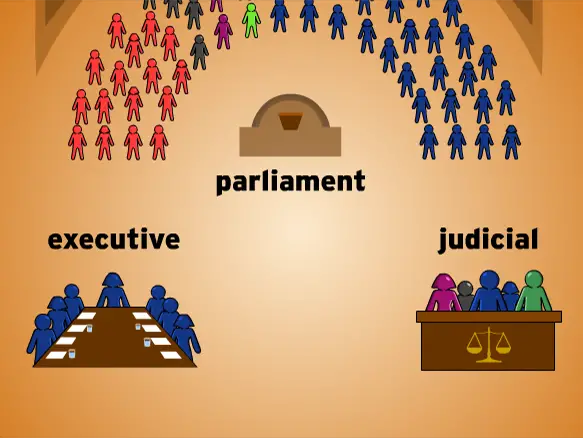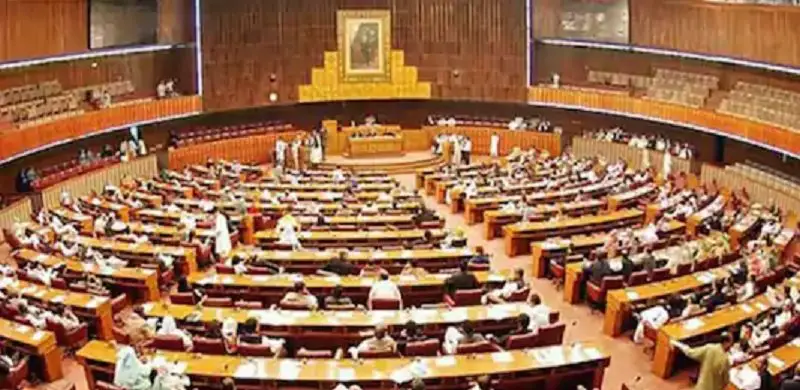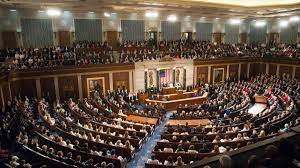Parliamentary democracy is arguably one of the most dominant forms of governance across the globe, with 51 out of 195 sovereign nations adopting this administrative system.
In this kind of democracy, the legislature and executive branches of government are intertwined.
The executive is held accountable to, and derives its permissibility from, the legislature.
What’s more, unlike in other forms of democratic systems, the head of government and the head of state are two distinct roles.
A case in point is the United Kingdom, commonly referred to as the “Mother of Parliaments”, where King Charles III is the official head of state while the Honorable Liz Truss is the ceremonial head of government.
In a parliamentary democracy, members of the Government are elected regularly by the public in a secret ballot.
Once voted in, the government is held accountable to the voters, as well as the Parliament.
A critical tenet of this liberal system is limiting the government’s powers over the masses.
A Bill of rights upholding the individual’s rights and freedoms is usually included in the country’s constitution, and the government is expected to advocate for these rights.
Distribution of Power in a Parliamentary Democracy
Parliamentary democracies are characterized by fusion of powers between the executive and the legislature.
This principle implies that there is interdependence between these two government organs wherein they perpetually audit each other’s performance.
However, the legislature assumes more power than the executive.
Parliament holds sway over the cabinet as it has the power to present motions, question the cabinet’s activities, and call for a vote of no confidence with an aim of removing the cabinet or a senior government official.
For instance, the UK parliament recently held a vote of no confidence against the country’s former Prime Minister, Boris Johnson, as MPs attempted to get rid of him.
Similarly, his predecessor, Lady Theresa May, also faced a vote of no confidence by MPs.
Although both prime ministers won their respective no-confidence votes, they soon stepped down, thus showing the legislature’s pre-eminence over the executive.
Examples of Parliamentary Democracies

1. The United Kingdom
The UK, which comprises Northern Ireland, England, Scotland, and Wales, is a parliamentary democracy founded on universal suffrage for all legal adults.
The monarch serves as the head of government and state, as well as the commander in chief of the Crown’s armed forces.
Members of parliament serve at the will of the head of state.
The UK has a bicameral parliament which comprises the House of Lords (upper chamber) and the House of Commons (lower chamber).
The upper chamber is hereditary and life peers, while members of the lower chamber are appointed after five years through elections.
The executive is led by the Prime Minister, who is head of the majority party in the House of Commons and is appointed by the King.
In turn, the Prime Minister is tasked with appointing members of the cabinet.
This organ of government is made up of cabinet members, public ministers, public corporations, and local authorities.
All legislation are passed by members of parliament and signed into law by the Prime Ministers.
However, Irish and Scottish laws are devolved to the Northern Ireland Assembly and the Scottish Parliament, respectively.
2. Antigua and Barbuda
This is a sovereign island nation that is part of the American West Indies.
It has a parliamentary democracy system whereby the monarch, officially known as the Sovereign of Antigua and Barbuda, serves as the head of the state.
The monarch appoints a Governor General who conducts all constitutional or civil government processes on behalf of and in the name of the monarch.
The Governor-General also appoints the Prime Minister who is the head of government.
The two appointed officials collaborate to appoint the Council of Ministers.
The government makes up the executive while the parliament and government make up the legislature.
Antigua and Barbuda’s parliament is bicameral as it comprises a House of Representatives and a Senate.
The latter is made up of 17 members appointed by the Governor General while the former is made up of 17 elected members, each serving a 5-year term.
3. Japan
This Asian nation has a one-party parliamentary democratic monarchy.
The leader of the Imperial Family of Japan, the Emperor, is the head of state, while the Prime Minister serves as the head of cabinet and government.
The Prime Minister is designated by the parliament and officially appointed by the Emperor.
The Cabinet of Japan is the sole executive organ of the nation’s government.
It is spearheaded by the Prime Minister and comprises 19 Ministers of State.
The legislature is conferred on the Japanese parliament, the National Diet.
It is made up of the House of Councilors which has 16 standing committees and the House of Representatives which has 18 standing committees.
Lastly, the judiciary comprises the Supreme Court and other lower courts.
4. The Bahamas
Officially called The Commonwealth of Bahamas, this is a West Indies state located in the Atlantic Ocean’s Lucayan Archipelago.
It has a parliamentary democracy monarchy led by its colonial monarch and head of state, King Charles III.
The King appoints a Governor-General who undertakes all constitutional and civil engagements on his behalf.
One of the integral roles of the Governor-General is appointing the Prime Minister, who is the head of government.
The Cabinet is appointed by the Prime Minister and holds all executive powers.
The legislature comprises a bicameral parliament with an elected House of Assembly and a state-appointed Senate.
5. Canada
In Canada, the monarch is the head of state. He appoints the Prime Minister of Canada who is the head of government.
This government features a committee of ministers of the Crown, the Prime Minister as the chairperson, and the Cabinet which is part of the Monarch’s Privy Council for Canada.
Its bicameral legislature includes the Crown, the Senate and the lower House of Commons.
6. Belgium
Belgium’s head of state, King Philippe, is the hereditary monarch, officially known as the King of the Belgians.
His role is rather a ceremonial being that his only role is appointing the Prime Minister after he is delegated by the lower parliamentary house.
The second-ranking official is the Prime Minister as he is head of government and the most powerful figure in Belgium’s multi-party political framework.
He spearheads the executive which is made up of the Council of Ministers and state secretaries.
The legislature is made up of Belgium bicameral parliament. These include the elected Chamber of Representatives (lower house) and the Senate (upper house).
The latter includes elected senators, those elected by provincial councils, those co-opted by fellow senators, and those elected by community parliaments.
7. Samoa
Samoa’s political framework takes on a parliamentary representative democratic approach.
Herein, the head of state, locally termed as ‘O le Ao Mamalu O le Malo’, is chosen from one of the four Samoan chiefly dynasties.
His highness appoints the Prime Minister every 5 years, who in turn serves as the head of government.
However, being that the head of state’s political role is largely ceremonial, the country’s legislative assembly (Fono Aoao Faitulafono) votes in a prime minister and forwards the name to the head of state for an appointment.
The Prime Minister then appoints a 12-member cabinet, who are also sworn in by the O le Ao o Ie Malo and make up the executive branch of government.
Inversely, the unicameral legislature comprises 49 elected officials who make up the Fono.
Based on principles of universal suffrage, 47 of these officials are elected from ethnic constituencies while the remaining 2 are elected from non-Samoan constituencies.
8. Spain
Spain’s monarchy is another ideal example of parliamentary democracy.
Constitutionally known as The Crown, the monarch is Spain’s head of state.
The government is the primary executive instrument and is chaired by the prime minister.
This organ also includes deputy prime ministers and regional ministers.
The Cortes Generales is the country’s bicameral parliament and the government’s legislative branch. It constitutes the Senate and Congress of Deputies.
Lastly, the judiciary, which serves independently from the legislature and executive, is run by magistrates and judges on behalf of the monarch.
9. Poland
The President of Poland is the head of state. He is elected by popular vote and is tasked with appointing the prime minister from the leading coalition or party.
As head of government, the prime minister appoints members of the bicameral parliament’s upper house.
Contrastingly, members of the lower house (Sejm) are elected by popular vote.
Noteworthy, unlike other parliamentary democracies, Poland’s head of state has veto powers as he can reject bills passed in parliament.
This unique attribute makes Poland’s political framework a de facto semi-presidential system.
10. Germany
In Germany, the federal parliament, known as the Bundestag, is elected by the German people.
This legislative council then elects the head of state, the Chancellor of Germany, who in turn elects members of the executive branch-the Cabinet.
Origin of Parliamentary Democracy

A. The Mediaeval Kingdom of Leon
In days of yore, tribal communities were led by councils, and village elders were tasked with appraising the counsels’ performance.
Today’s parliamentary democracies evolved from this ancient form of governance.
The first ever documented parliamentary democracy in history can be traced back to the Mediaeval Kingdom of Leon, present-day Spain, which was established by King Alfonso XI in 1188.
While facing a serious threat of invasion by the Portuguese and the Kingdom of Castile, the legendary Spanish leader summoned members of the king’s court, locally known as the curias regis, and representatives of notable merchants to the San Isadora Basilica.
The aim of this meeting was to strategize on how to protect the country’s borders from the looming attack.
However, the meetings gradually took center stage in Alfonso IX’s governance as the royal council became the country’s primary form of governance.
King Alfonso consulted with the noble council before engaging in war and it also dealt with matters pertaining to justice appeals, private property rights, and religious inviolability.
B. Simon V de Montfort
King Alfonso IX’s royal court paved the way for other parliamentary democracies across the globe.
England followed soon after under the stewardship of King Henry III’s successor, Simon V de Montfort.
Simon convened the initial parliament in 1258 and the second in 1265. The former nullified the king’s absolute authority, while the latter accounted for the rights of ordinary English citizens.
Both parliaments culminated in The Glorious Revolution of 1688 which established the landmark 1689 Bill of Rights.
C. Colonialism and World Wars I & II
By the early 19th century, this form of governance had spread out to other parts of the globe, most notably British dominions such as the Union of South Africa, Australia, and the Irish Free State.
Parliamentary democracy continued to grow in relevance after World War I as the democratic conquerors, France, Great Britain and US, imposed this form of governance on conquered nations, such as the First Austrian Republic and the German Reich.
It was a similar case after the Axis powers were defeated in World War II as Allied forces implemented parliamentary constitutions in Japan, Italy and West Germany.
Today, parliamentary democracy has spread out to all corners of the globe, making it one of the most dominant forms of governance.
Features of Parliamentary Democracy

I. Bicephalous Executive
Unlike in presidential systems where the executive is headed by the president, parliamentary democracy executives are headed by two individuals, namely, the prime minister and the president.
However, the president is a glorified position that lacks much power under the parliamentary system.
II. Office Terms
There is no specific term of office for the Prime Minister.
He/she remains in office for as long as the legislature (parliament) is content with his/her performance.
In cases where the parliament is dissatisfied with the Prime Minister’s performance, parliament casts a vote of no confidence and a majority vote will immediately eject the Prime Minister from office.
III. Formulating Legislations
While the president signs bills into laws in the presidential system, the Prime Minister performs this duty in a parliamentary system.
A majority vote in parliament passes the bill, after which the Prime Minister officiates the legislation.
However, he has no veto powers to reject a bill that is passed by parliament.
IV. Political Parties
Parliamentary democracy can adopt a multi-party, uni-party, or bi-party system depending on the parliamentary system.
Examples of uni-party states include Cuba with the Cuban Communist Party and China with the Communist Party of China.
In such cases, members of parliament come from a single party.
However, a multi-party parliamentary system is more democratic given that members of parliament are elected from different political affiliations, thus creating a more representative legislature.
V. Party Unity
Another standout attribute of parliamentary democracies is party unity.
Parliamentary party groups often form coalitions with an aim of swaying specific voting decisions.
It is not uncommon for members of parliament from opposing political affiliations to get into temporary unions.
This coalition strategy is mostly used in cases where the majority party significantly outnumbers other party groups, thus the need for an alliance to push common objectives.
VI. Legislature’s Collective Responsibility
While the legislature is not above the constitution, it holds dominion over other arms of government, making it the supreme overlord in parliamentary democracies.
This government organ appoints members of the executive and holds them accountable for their actions.
Legislature has the power to vote out underperforming members of the executive.
However, this collective responsibility is most effective in countries where royalties do not make up the executive.
Pros and Cons of Parliamentary Democracy System

Pros
a. Frequent Elections
Under this form of governance, the government can call for elections if it fails to meet the legislative majority requisite for optimum legitimacy.
Also, the public can call for elections if they feel the government is underperforming.
b. Promotes Accountability
This centralized form of governance allows for transparency since the public holds the government accountable while the government holds the executive and other organs of government accountable.
c. Adaptability
Such systems are also hailed for their regulatory flexibility.
There are few limits associated with changing policies and legislations so long as this change is backed by a distinct majority or viable party coalition.
d. Easier Party Registration
The primary tenet of parliamentary democracy is political party groups.
As such, formulating political parties is not limited by highly bureaucratic regulations, making it easier to form one than in presidential systems.
A significant factor, in this case, is that a political party is not required to have a huge national following to acquire a lease of life.
Therefore, all residents have a fair chance of incorporating their voices in political engagements.
Cons
a. Misrepresentation of Local Concerns
Elected officials are at times forced to compromise their local grievances to align with the will of the majority.
Unfortunately, many times, the majority do not consider the plight of people at the local level.
b. Political Inconsistency
Another notable disadvantage of parliamentary democracies is governmental instability.
For instance, if one party that is part of the majority coalition disagrees with the group’s ideologies, the party is removed from the coalition and a special election takes place to fill the position.
Ultimately, this leads to a new coalition leader and a change in the majority’s direction, bringing about major inconsistencies in governance.
c. Suppresses Voter Influence
The public is disenfranchised as they do not have a say in the head of state appointments.
The legislature is the root cause of this disenfranchisement since it assumes majority of the power in most political appointments and decisions.
Conclusion
In sum, parliamentary democracies are systems where the executive is held accountable to, and derives its permissibility from, the legislature.
What’s more, unlike in other forms of democratic systems, the head of government and the head of state are two distinct roles.
The origin of this political system dates back to the Medieval Kingdom of Leon in 1188.
Today, this is among the most dominant governance systems globally.
Some countries that have adopted this structure include Samoa, Germany, Poland, Canada, and Japan.

